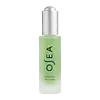What's inside
What's inside
 Key Ingredients
Key Ingredients

 Benefits
Benefits

 Concerns
Concerns

No concerns
 Ingredients Side-by-side
Ingredients Side-by-side

Aloe Barbadensis Leaf Juice
Skin ConditioningHelianthus Annuus Seed Oil
EmollientRheum Palmatum Root Extract
AstringentAlthaea Officinalis Root Extract
Skin ConditioningVitis Vinifera Seed Extract
AntimicrobialFragaria Chiloensis Fruit Extract
Skin ConditioningOryza Sativa Extract
AbsorbentVitis Vinifera Seed Oil
EmollientGlycerin
HumectantCaprylyl Caprylate/Caprate
EmollientCaprylic/Capric Triglyceride
MaskingUndecane
EmollientTridecane
PerfumingWater
Skin ConditioningPanthenol
Skin ConditioningAloe Barbadensis Leaf Extract
EmollientPPG-20 Methyl Glucose Ether
Skin ConditioningSodium Hyaluronate
HumectantFragaria Vesca Fruit Extract
AstringentRheum Rhabarbarum Extract
Skin ConditioningXylitylglucoside
HumectantAnhydroxylitol
HumectantXylitol
HumectantBeta Vulgaris Root Extract
Skin ConditioningCarbomer
Emulsion StabilisingBenzyl Alcohol
PerfumingHeptyl Glucoside
1,2-Hexanediol
Skin ConditioningCaprylyl Glycol
EmollientTropolone
Skin ConditioningVitis Vinifera Juice Extract
AntioxidantSucrose
HumectantPectin
Emulsion StabilisingCitric Acid
BufferingPropanediol
SolventSodium Benzoate
MaskingParfum
MaskingEuterpe Oleracea Fruit Extract
Citrus Limon Juice
Skin ConditioningMalpighia Glabra Fruit Extract
Skin ConditioningEmblica Officinalis Fruit Extract
Skin ConditioningAdansonia Digitata Fruit Extract
EmollientMyrciaria Dubia Fruit Extract
Skin ConditioningDaucus Carota Sativa Root Extract
Skin ConditioningCocos Nucifera Water
MaskingLycium Barbarum Fruit Extract
AstringentMaltodextrin
AbsorbentAloe Barbadensis Leaf Juice, Helianthus Annuus Seed Oil, Rheum Palmatum Root Extract, Althaea Officinalis Root Extract, Vitis Vinifera Seed Extract, Fragaria Chiloensis Fruit Extract, Oryza Sativa Extract, Vitis Vinifera Seed Oil, Glycerin, Caprylyl Caprylate/Caprate, Caprylic/Capric Triglyceride, Undecane, Tridecane, Water, Panthenol, Aloe Barbadensis Leaf Extract, PPG-20 Methyl Glucose Ether, Sodium Hyaluronate, Fragaria Vesca Fruit Extract, Rheum Rhabarbarum Extract, Xylitylglucoside, Anhydroxylitol, Xylitol, Beta Vulgaris Root Extract, Carbomer, Benzyl Alcohol, Heptyl Glucoside, 1,2-Hexanediol, Caprylyl Glycol, Tropolone, Vitis Vinifera Juice Extract, Sucrose, Pectin, Citric Acid, Propanediol, Sodium Benzoate, Parfum, Euterpe Oleracea Fruit Extract, Citrus Limon Juice, Malpighia Glabra Fruit Extract, Emblica Officinalis Fruit Extract, Adansonia Digitata Fruit Extract, Myrciaria Dubia Fruit Extract, Daucus Carota Sativa Root Extract, Cocos Nucifera Water, Lycium Barbarum Fruit Extract, Maltodextrin
Water
Skin ConditioningCodium Fragile Extract
Skin ConditioningBetaine
HumectantSodium Hyaluronate
HumectantTremella Fuciformis Sporocarp Extract
AntioxidantBacillus Ferment
Skin ConditioningHydrolyzed Hyaluronic Acid
HumectantGlycerin
HumectantSodium Benzoate
MaskingPotassium Sorbate
PreservativeCitric Acid
BufferingLonicera Japonica Flower Extract
Skin ConditioningLonicera Caprifolium Flower Extract
PerfumingCopper Chlorophyll
Cosmetic Colorant
 Reviews
Reviews

Ingredients Explained
These ingredients are found in both products.
Ingredients higher up in an ingredient list are typically present in a larger amount.
Citric Acid is an alpha hydroxy acid (AHA) naturally found in citrus fruits like oranges, lemons, and limes.
Like other AHAs, citric acid can exfoliate skin by breaking down the bonds that hold dead skin cells together. This helps reveal smoother and brighter skin underneath.
However, this exfoliating effect only happens at high concentrations (20%) which can be hard to find in cosmetic products.
Due to this, citric acid is usually included in small amounts as a pH adjuster. This helps keep products slightly more acidic and compatible with skin's natural pH.
In skincare formulas, citric acid can:
While it can provide some skin benefits, research shows lactic acid and glycolic acid are generally more effective and less irritating exfoliants.
Most citric acid used in skincare today is made by fermenting sugars (usually from molasses). This synthetic version is identical to the natural citrus form but easier to stabilize and use in formulations.
Read more about some other popular AHA's here:
Learn more about Citric AcidGlycerin is already naturally found in your skin. It helps moisturize and protect your skin.
A study from 2016 found glycerin to be more effective as a humectant than AHAs and hyaluronic acid.
As a humectant, it helps the skin stay hydrated by pulling moisture to your skin. The low molecular weight of glycerin allows it to pull moisture into the deeper layers of your skin.
Hydrated skin improves your skin barrier; Your skin barrier helps protect against irritants and bacteria.
Glycerin has also been found to have antimicrobial and antiviral properties. Due to these properties, glycerin is often used in wound and burn treatments.
In cosmetics, glycerin is usually derived from plants such as soybean or palm. However, it can also be sourced from animals, such as tallow or animal fat.
This ingredient is organic, colorless, odorless, and non-toxic.
Glycerin is the name for this ingredient in American English. British English uses Glycerol/Glycerine.
Learn more about GlycerinSodium Benzoate is a preservative. It's used in both cosmetic and food products to inhibit the growth of mold and bacteria. It is typically produced synthetically.
Both the US FDA and EU Health Committee have approved the use of sodium benzoate. In the US, levels of 0.1% (of the total product) are allowed.
Sodium benzoate works as a preservative by inhibiting the growth of bacteria inside of cells. It prevents the cell from fermenting a type of sugar using an enzyme called phosphofructokinase.
It is the salt of benzoic acid. Foods containing sodium benzoate include soda, salad dressings, condiments, fruit juices, wines, and snack foods.
Studies for using ascorbic acid and sodium benzoate in cosmetics are lacking, especially in skincare routines with multiple steps.
We always recommend speaking with a professional, such as a dermatologist, if you have any concerns.
Learn more about Sodium BenzoateSodium Hyaluronate is hyaluronic acid's salt form. It is commonly derived from the sodium salt of hyaluronic acid.
Like hyaluronic acid, it is great at holding water and acts as a humectant. This makes it a great skin hydrating ingredient.
Sodium Hyaluronate is naturally occurring in our bodies and is mostly found in eye fluid and joints.
These are some other common types of Hyaluronic Acid:
Learn more about Sodium HyaluronateWater. It's the most common cosmetic ingredient of all. You'll usually see it at the top of ingredient lists, meaning that it makes up the largest part of the product.
So why is it so popular? Water most often acts as a solvent - this means that it helps dissolve other ingredients into the formulation.
You'll also recognize water as that liquid we all need to stay alive. If you see this, drink a glass of water. Stay hydrated!
Learn more about Water